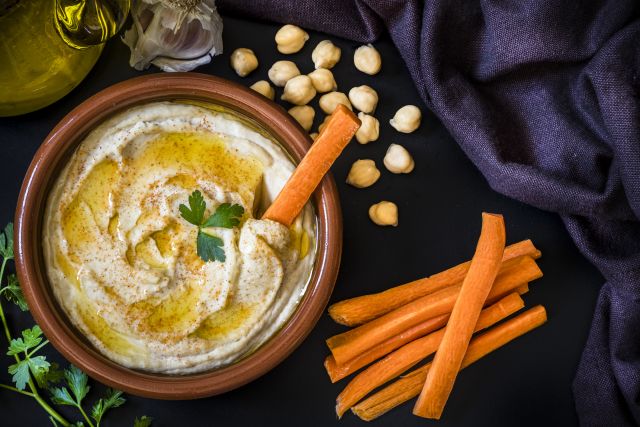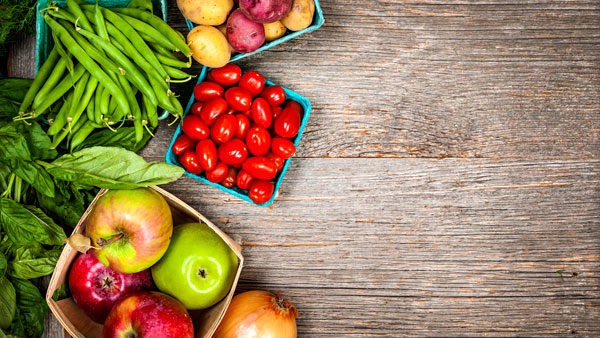Updated on May 31, 2023.
Once an exotic dish found mostly in health-food and specialty stores, hummus has become a staple of refrigerated sections in supermarkets across the country. And with good reason: The dip is versatile, delicious, and high in protein and healthy fats. Plus, research shows it may benefit your heart health, help reduce the risk of diabetes, and help manage your weight.
What is hummus?
Hummus is an ancient meze (a side dish or appetizer) that originates in the Mediterranean and Middle East regions. It’s made from blending two main ingredients: chickpeas and tahini.
Chickpeas are pulses, or edible seeds of plants from the legume family. Also known as garbanzo beans, they contain protein, fiber, and unsaturated fats. They also boast vitamins and minerals including riboflavin, niacin, thiamin, folate, potassium, phosphorus, and calcium. Tahini, a paste made from blended sesame seeds, contains unsaturated fatty acids, antioxidants, calcium, and phosphorus.
Other ingredients in hummus can vary, but the traditional recipe typically includes garlic, olive oil, and lemon juice. These ingredients are components of the Mediterranean diet, an eating plan that highlights regular intake of healthy fats, fresh produce, and beans, nuts, and seeds. This diet may improve cardiovascular health and reduce the risk of chronic health conditions, like diabetes and obesity.
A two-tablespoon serving of commercially made hummus contains approximately:
- 67 calories
- 2 grams of protein
- 5 grams of fat (mostly the healthy mono- and polyunsaturated kinds)
- 1.5 grams of fiber
Hummus for the heart
Chickpeas are beneficial for heart health because they contain a range of antioxidants. (In fact, chickpeas come in a range of colors, including black, red, brown, and green, along with the classic creamy beige color. The darker the skin, the greater the antioxidant capacity.)
Chickpeas are also high in healthy polyunsaturated fat and low in saturated fat. They are also a good source of fiber, which binds to, and then excretes, excess cholesterol from the gut.
Managing your cholesterol levels is important for heart health. Research has found that eating chickpeas regularly may lower fasting total cholesterol levels by as much as 22 percent. This can go a long way toward lowering the risk of heart disease and mortality from heart-related conditions.
Reducing risk of type 2 diabetes
If you have, or are at risk for, type 2 diabetes, you may need to be careful with your intake of carbohydrates to help maintain steady levels of blood glucose. But healthy carbs like those found in hummus could help you manage the condition.
In a 2017 study published in the Journal of Food Science and Technology, researchers gave participants equal amounts of white bread or chickpeas. Those who ate chickpeas had more stable blood glucose levels in the two hours after eating.
A small study in 2015 in Nutrition Journal found that people who ate white bread had blood glucose peaks that were significantly higher than those who ate hummus. The study authors hypothesized that the fiber content and beneficial starch in hummus helps the body absorb the carbs more slowly over a longer period of time, which can help regulate blood glucose levels.
Help with weight management
Maintaining a healthy weight and managing type 2 diabetes are linked. It is estimated that people who are obese—those with a body mass index (BMI) of 30 or greater—are about 80 times more likely to be diagnosed with type 2 diabetes than those with a BMI of less than 22. Hummus may be beneficial for keeping both a healthy weight and reducing the risk of type 2 diabetes.
Adults who ate an afternoon snack of hummus and pretzels over the course of a week had improved blood glucose levels, were less hungry afterward, and were less likely to have a dessert later in the day compared to those who either ate no snack or who snacked on granola bars, according to a 2020 study published in the Journal of Nutrition.
An analysis of studies in The American Journal of Clinical Nutrition published in 2016 found that eating one serving of pulses a day helped people lose just under one pound over about six weeks—even if people weren’t otherwise restricting their calories.
The Journal of Food Science and Technology article also found that people who consumed chickpeas appeared to require less energy from food at their next meal. Translation: They felt fuller longer. This could be due to the effects of fiber and protein in chickpeas or from steadier blood sugar levels, which may reduce cravings.
How to hummus
Hummus is traditionally eaten as a dip with pita bread or vegetables or as a sandwich spread. But it has uses far beyond these examples. It can be used to thicken pasta sauce or as a replacement for mayonnaise in dressings and chicken salad. Flour made from dried chickpeas can also serve as a high-fiber, protein-rich replacement for refined flour.
The easiest way to nosh on hummus is to buy it in the store, where it can be found in a range of flavors, spice levels, and with a variety of toppings. To choose the best hummus, follow these tips:
Keep it real. As much as possible, avoid preservatives like potassium benzoate, sodium benzoate, and potassium sorbate, all commonly found in premade hummus. If you can’t pronounce it, don’t eat it.
Take heed of fat. Buy hummus with olive oil instead of other, less healthy fats like soybean oil, found in many packaged brands.
Mind your sodium. Remember, one serving of hummus is about 2 tablespoons, but it’s easy to eat more than that. Choose hummus that has no more than 30 to 50 mg of sodium per serving to keep your intake at manageable levels.
Be smart with additions
Making your own hummus is surprisingly simple, and it’s a good way to save money and control the ingredients you are eating. The basic recipe is the blend canned chickpeas (drained and rinsed) with garlic, tahini, and lemon juice. From there, you can add seasonings and garnishes to suit your taste, from smoked paprika to bell peppers to jalapenos.
It’s also important to watch for hidden gluten in hummus. If you have an allergy, make sure the product is labeled gluten-free. Also, remember that tahini is made from sesame seeds, so if you have an allergy, steer clear, or make your own without the paste. It may be a little less smooth but will taste just as good.







